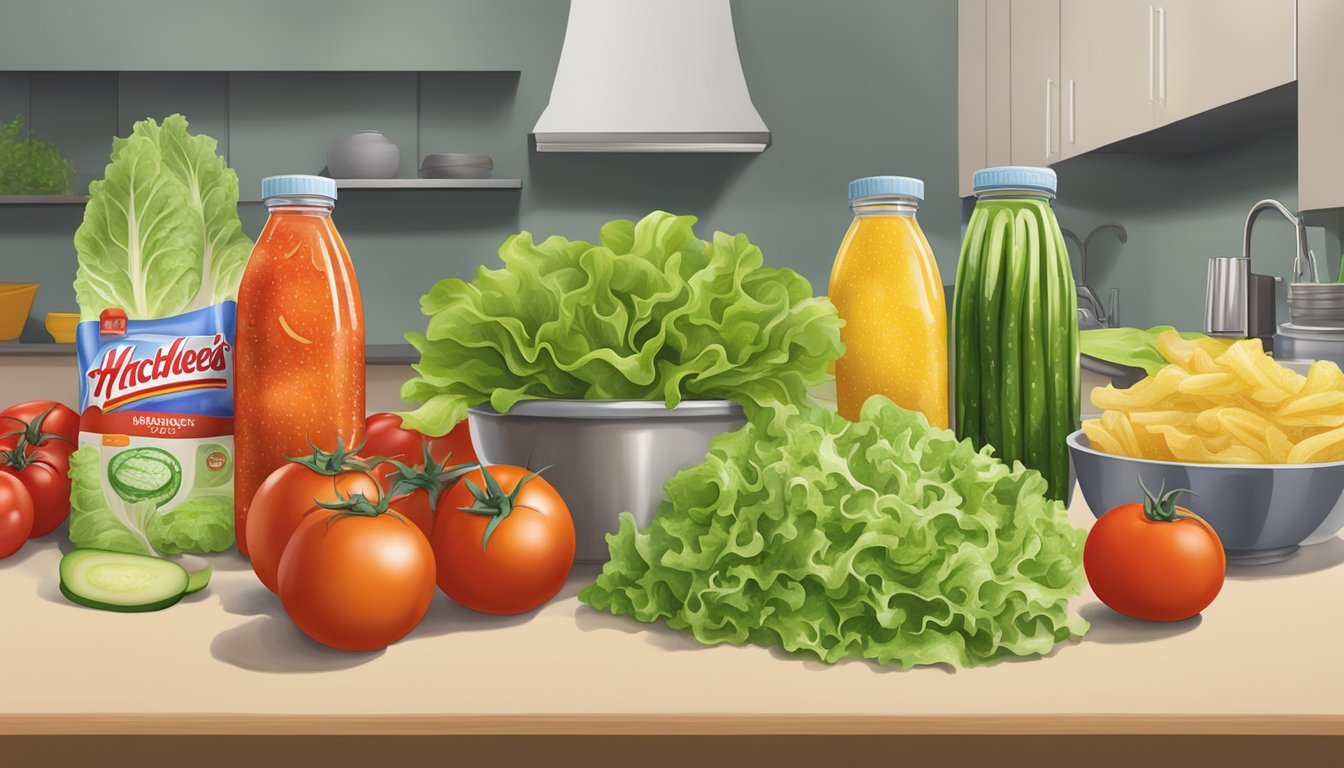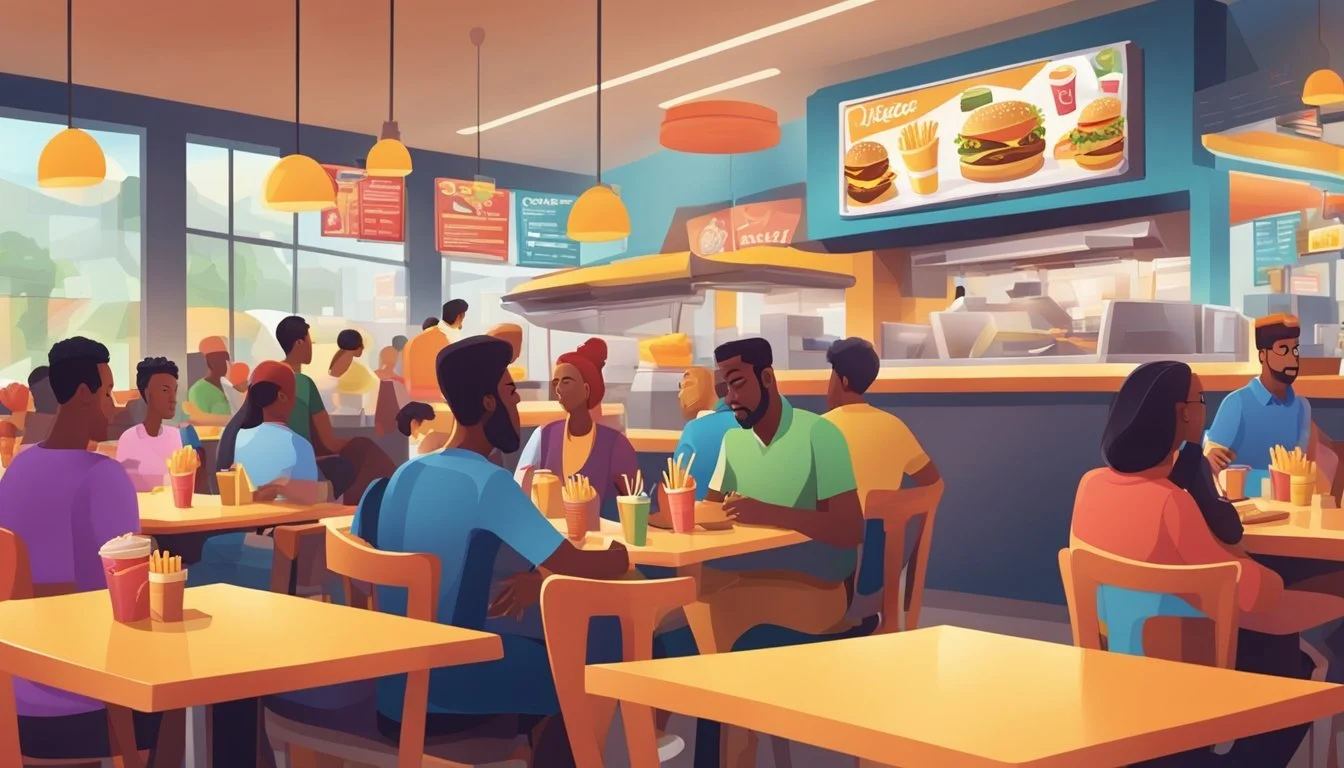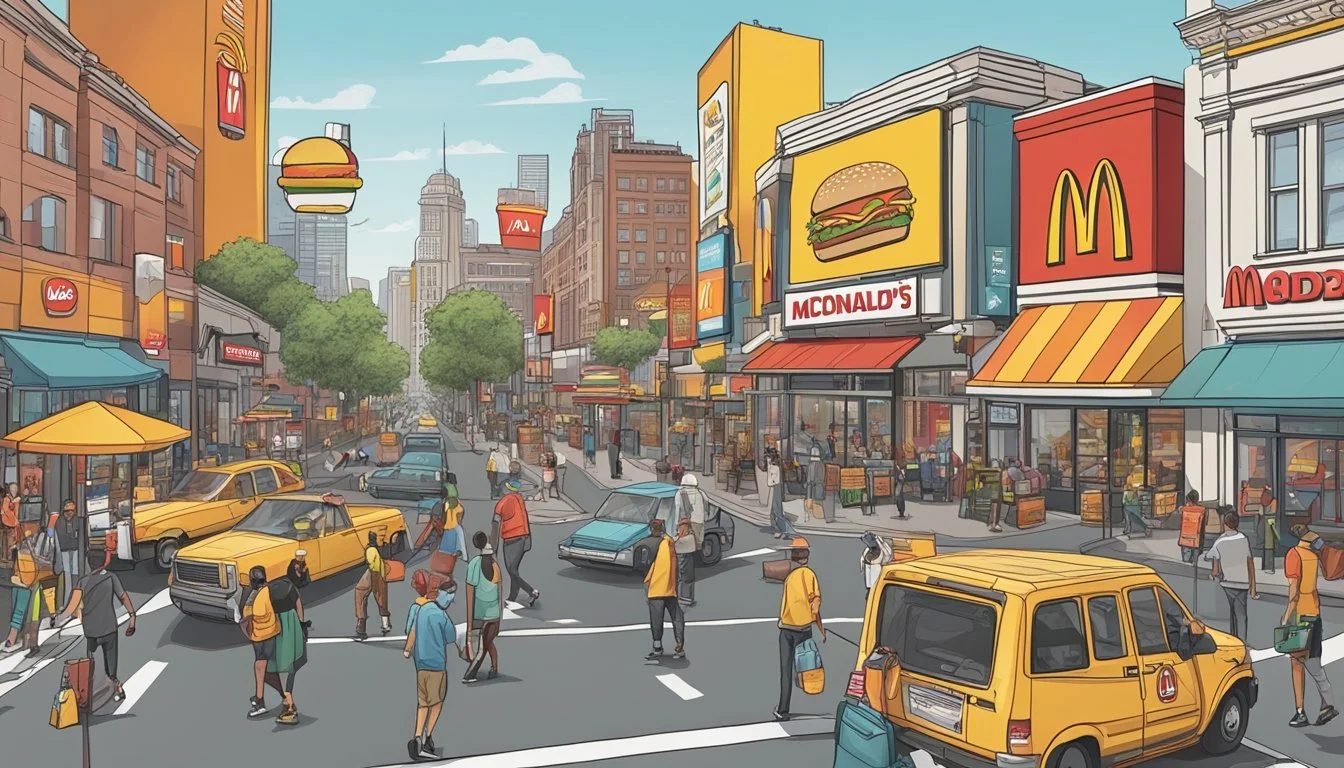McDonald's vs Hardee's
A Comprehensive Comparison of Burger Giants
When it comes to burger joints in America, McDonald's and Hardee's stand out for their distinctive approaches to serving quick, savory bites. McDonald's, a global giant with a massive presence, is recognized for its consistent flavor profile and quick service. Its burgers, like the Big Mac, have become cultural icons. Hardee's, though less widespread than McDonald's, offers its own take on burgers, with thicker patties and a variety of options that cater to those looking for a more substantial bite.
Debates often arise about which chain provides the better burger experience. Customers weigh factors such as the quality of meat, the freshness of ingredients, and the overall taste when choosing their preferred burger destination. While McDonald’s burgers are known for their classic, familiar taste that resonates with fans worldwide, Hardee's tends to go for a more premium feel with its charbroiled burgers and signature sandwiches, such as the Super Star with Cheese.
The competition between McDonald's and Hardee's is more than just about taste—it's also about the dining experience, customer service, and value for money. Each brand has its loyalists who argue fervently in favor of their preferred chain, making this an enduring topic for discussion among fast-food aficionados.
Brand History and Presence
McDonald's set the stage for the fast-food industry with its inception in 1940. It has since grown to be ubiquitous, with a powerful global presence. As arguably the front-runner in the fast-food arena, McDonald's operates in scores of countries and maintains a hearty brand recognition.
Hardee's, while a key player, began its journey in 1960. In contrast, Carl's Jr., which shares corporate ties with Hardee's after being purchased in 1997, was founded earlier in 1941. Both these brands have retained their unique identities, despite their collaboration to form a larger national chain. Hardee's once pursued growth by acquiring other chains such as Sandy's and Burger Chef.
Comparing them with other industry giants, Burger King, established in 1954, and Wendy's, founded in 1969, have also carved significant quarters in the market. While Burger King holds its own, Wendy's briefly found itself outpaced by Hardee's.
Other competitors like Dairy Queen and A&W pioneer in their own right, have a nostalgic charm. White Castle claims the title of the first fast-food hamburger chain, while Checkers and Sonic continue to be strong region-specific contenders.
The industry has not been without its innovators, with Shake Shack and Smashburger offering more of an upscale burger. Meanwhile, Fuddruckers and Culver's present a more sit-down dining experience. Five Guys stands out by offering a robust selection of free toppings, and Jack in the Box, with its varied menu, retains a faithful customer base.
In New York, local restaurants and smaller chains like Shake Shack, which originated in Manhattan, compete with the ubiquity of McDonald's branches. In Brooklyn and beyond, these brands must adapt and define their presence to resonate with local tastes and preferences.
Each chain aims to distinguish itself through various strategies, whether it be via menu options, branding, or geographic reach.
Menu Varieties and Signature Items
When examining the menu options of McDonald's and Hardee's, patrons are greeted with a wide array of choices, though each restaurant has its distinctive signature items. McDonald's is renowned for its iconic Big Mac, a staple in the burger market with two all-beef patties, special sauce, lettuce, cheese, pickles, onions, and a sesame seed bun. They also offer the Quarter Pounder, a burger featuring a quarter pound of beef that has consistently been a fan favorite. Regarding chicken products, McDonald's Chicken McNuggets serve as a popular entrée or side item, with a variety of dipping sauces enhancing the experience.
Hardee's, on the other hand, presents a competitive array of burgers including the Thickburger line, which is a cornerstone of their menu known for its thick, juicy beef patties and a variety of toppings. While not as universally recognized as the Big Mac, Hardee's burgers, such as the Monster Thickburger, are often celebrated for their hearty portions and flavorful combinations.
Both establishments boast a selection of cheeseburgers, hamburgers, and fries, pivotal aspects of any fast-food menu. McDonald's offers a classic range of hamburgers and cheeseburgers, with the Double Cheeseburger being a go-to option for those seeking a more filling meal without complexity. Hardee's also features a selection of cheeseburgers that align with their Thickburger branding, assuring customers of a substantial meal.
In conclusion, both McDonald's and Hardee's provide extensive menu items ranging from burgers to chicken offerings, including nuggets and various chicken entrées. Each has carved out a unique niche in the fast-food market with their standout items, catering to a wide spectrum of taste preferences and appetites.
Ingredient Quality and Sourcing
When comparing McDonald's to Hardee's, the focus on ingredient quality and sourcing is a key differentiator. Each brand has distinct approaches to procuring ingredients, from beef and bakery items to dairy products, impacting the overall dining experience.
Fresh Beef vs Frozen Beef
McDonald's prides itself on sourcing 100% fresh beef for its Quarter Pounder burgers in the United States, aiming to deliver a juicier and more flavorful patty. They avoid preservatives, fillers, or additives in their fresh beef, emphasizing a commitment to quality. Meanwhile, Hardee's differentiates its beef offerings by using 100% Black Angus beef, which is well-regarded for its tenderness and taste, albeit their patties are prepared as frozen.
Bun and Bakery Selection
The bun is a foundational component of any burger, and both chains pay close attention to their selection. McDonald's uses a variety of buns, including the classic sesame seed bun, which contains ingredients like wheat flour and sugar. Hardee's, on the other hand, offers a Fresh Baked Bun option that they tout as being baked fresh in-restaurant each day, which could provide a fresher taste and texture.
Dairy and Cheese Choices
For their cheeseburgers, both McDonald's and Hardee's typically use American cheese. McDonald's cheese is processed and contains ingredients such as milk, cheese culture, and enzymes. At Hardee's, their cheese options also include American cheese that features dairy elements combined with cream, water, and cheese culture, aiming to deliver a rich and creamy flavor profile. Furthermore, both establishments source potato products such as French fries, with McDonald's notably committing to sourcing potatoes in a manner that supports sustainable farming practices.
Flavor Profiles and Taste Comparisons
When comparing McDonald's and Hardee's, the distinct flavor profiles created by their unique combinations of condiments, quality of patties, and variety of extras define their burgers.
Condiments and Special Sauce
McDonald's special sauce, particularly on the Big Mac, is a signature flavor that combines elements of sweetness, tanginess, and a subtle hint of spice. The precise blend of mayo, sweet relish, yellow mustard, vinegar, garlic powder, onion powder, and paprika contributes to its popularity. In contrast, Hardee’s offers a range of condiments including ketchup, mustard, mayo, and BBQ sauce, but they're more traditional in their flavor profiles without a standout signature sauce.
Taste of the Patty
The taste of the patty is a critical aspect of any burger experience. McDonald’s uses a seasoned beef patty that’s often noted for its consistent, albeit simple, salt and pepper flavor. Hardee's, on the other hand, focuses on a thicker, charbroiled patty that imparts a smokier, more grilled taste which some might find gives a more authentic burger experience.
Toppings and Extras
Both chains offer standard toppings like lettuce, tomato, pickles, and onions. However, McDonald’s keeps its topping combinations quite basic, aiming for a classic taste that's been consistent over time. Hardee’s has a more generous approach to toppings and extras, including options like grilled onions, grilled mushrooms, and jalapenos for customers to personalize their burgers, potentially leading to a more flavorful and textured experience.
Health and Nutrition Considerations
When it comes to McDonald's and Hardee's, a discerning diner looks at calories, fat content, and nutritional information to determine which burger joint might be the healthier option.
McDonald's offers a variety of options with lower calorie counts and fat content. For example, their classic Cheeseburger is lighter compared to Hardee's offerings containing approximately 300 calories and 12 grams of fat.
In contrast, Hardee's is known for its Thickburgers, generally higher in calories and fat. A typical Original Thickburger has approximately 780 calories and 50 grams of fat.
McDonald's Cheeseburger
Calories: ~300
Total Fat: 12 g
Hardee's Original Thickburger
Calories: ~780
Total Fat: 50 g
Nutritional variety is another aspect where McDonald's demonstrates its understanding of health-conscious choices by providing items like the Fruit & Maple Oatmeal and salads. They provide transparency in their nutritional information, which is easily accessible for customers to make informed choices.
Hardee's also offers nutritional information, with a shift towards including charbroiled and chicken options to cater to those looking for less fat in their meals.
In terms of healthier options, both joints have made efforts to include alternative choices such as grilled products and salads. They also both demonstrate a certain level of commitment towards providing nutritional transparency to customers.
Examining McDonald's and Hardee's, customers should weigh the calorie count, fat content, and nutritional diversity available to align with their dietary goals.
Price Points and Value for Money
When assessing the price points between McDonald's and Hardee's, consumers often weigh the value they receive for the money they spend. At McDonald's, the cheapest burger is the classic hamburger, typically priced around $1.69. In contrast, Hardee's offers budget-friendly items that are, on average, substantially less expensive.
McDonald’s most expensive burger, notably enhanced with bacon and cheese, sits at the higher end of the scale at $8.00. Hardee's, on the other hand, also showcases higher-priced items, suggesting the presence of premium options.
Here's a succinct comparison:
Cheapest Burger:
McDonald's: Hamburger - $1.69
Hardee's: Pricing suggests options cheaper than McDonald's by over 250%
Most Expensive Burger:
McDonald's: Double Quarter Pounder with Bacon and Cheese - $8.00
Hardee's: Offers more expensive products but exact pricing not specified.
For customers, the value is not just about the cost but also what is received for the price. Both eateries provide a range of burgers that align with various budget constraints. However, a customer's perception of value might be influenced by the size, ingredients, and taste preferences which are subjective and can vary greatly.
In terms of value for money, both brands strive to balance cost with quality. Whether it is the variety of free toppings at other burger joints, like Five Guys, or the simply classic offerings of McDonald's, consumers have ample choice to fulfill their value expectations within the realm of fast food options.
Dining Experience and Atmosphere
When comparing the dining experiences at McDonald's and Hardee's, focus is generally placed on their drive-thru service, the ambiance of their diners, and the attention paid to seating and cleanliness.
Drive-Thru Service
Both McDonald's and Hardee's have heavily invested in their drive-thru services. McDonald's often edges out competition with its speedy service, attributed to its sophisticated order processing systems and double lanes that keep the wait time short. Hardee's drive-thru is efficient but does not typically feature the same level of high-tech enhancements.
Diner Ambiance
The ambiance inside a Hardee's diner is often perceived as more relaxed compared to McDonald's, with an emphasis on a sit-down dining experience. McDonald's, while maintaining a consistent and family-friendly atmosphere, leans more toward a fast and efficient dining environment, catering to customers who are on-the-go.
Seating and Cleanliness
Both brands prioritize cleanliness but there might be differences in the seating options. McDonald's restaurants usually have a uniform seating arrangement that is designed to accommodate a large number of customers, focusing on functionality. In contrast, Hardee's seating may offer a bit more diversity in design, with some locations providing a combination of booths, tables, and counter seating that gives a slight edge in comfort.
Customer Loyalty and Brand Affinity
When assessing the performance of McDonald's and Hardee's, customer loyalty and brand affinity come into focus as critical factors. Both chains have developed their respective strategies to secure repeat patronage and enhance their brand perception.
McDonald's relies on its loyalty program, MyMcDonald’s Rewards, which operates through an app-based, tiered system. Customers earn points for purchases, incentivizing further engagement. This system has been influential in driving repeat business and is reflective of McDonald's reputation for value and convenience.
Hardee's, in contrast, does not have a similarly publicized loyalty program. Despite this, its customers might remain loyal due to menu offerings and service quality.
Customer Satisfaction Ratings:
McDonald's: An analysis hints at a higher customer satisfaction rate for McDonald's with a reported rating of 1.07, indicative of effective customer service.
Hardee's: Specific ratings for Hardee's were not mentioned, suggesting room for improvement or less focus on such metrics.
The reputation of a fast-food chain is also built on customer experience. A positive association can lead to sustained customer loyalty, thereby enhancing lifetime value and the brand's overall strength.
McDonald's
Loyalty Program: MyMcDonald's Rewards: App-based points system
Customer Service: Higher satisfaction score, suggesting strong customer service
Hardee's
Loyalty Program: Less emphasis on formalized loyalty program
Customer Service: Customer service effectiveness less clear
McDonald's strategic focus on customer experience and a structured loyalty program evidently supports its brand loyalty. Hardee's may leverage other strengths to maintain its customer base, but specifics surrounding its customer loyalty tactics remain less documented.
Innovation and Market Trends
When observing the competitive landscape of fast-food burger joints, McDonald's and Hardee's demonstrate distinctive approaches to innovation and responsiveness to market trends. McDonald's, as a global leader, consistently integrates innovative technology to heighten efficiency and customer engagement. With acquisitions such as Dynamic Yield in 2019, McDonald's customizes the customer experience through AI-driven recommendations, reflecting an attentiveness to digital trends. In contrast, Hardee's innovation efforts are less publicized but often focus on menu diversification to cater to evolving consumer tastes.
Market Trends:
Increasing demand for technology integration in ordering and delivery services.
Personalized customer experiences through technology.
Shift towards more diversified menu options including healthier and plant-based alternatives.
McDonald's Innovations:
Digital Kiosks: Self-ordering to reduce wait times.
Mobile App: For easy ordering and loyalty rewards.
AI Technology: To personalize drive-thru experiences.
Hardee's Innovations:
Menu Innovations: Introduction of beyond meat options.
Limited Time Offers: To attract customers with new products.
McDonald's focus on digital growth appears to resonate well within the stock market, as it saw a positive stock performance in 2022, contrasting with market declines seen in indexes like the S&P 500. On the other hand, Hardee's tends to introduce new products and engage customers with limited time offers. One cannot ignore Hardee's efforts to remain relevant by adhering to consumer's shifting preferences towards alternatives like beyond meat options, despite a quieter presence in the technology arena. McDonald's, however, maintains its lead through a clear emphasis on tech-enabled service efficiency and a broad international footprint.
Sustainability and Corporate Responsibility
McDonald's and Hardee's are prominent players in the fast-food industry, each with its approach to sustainability and corporate responsibility.
McDonald's claims a purpose of feeding and fostering communities, reflecting a significant focus on sustainability. They have identified five key areas under their Better M initiative: packaging and recycling, climate action, beef sustainability, youth opportunity, and commitment to families. Their initiatives include the McDonald's Chicken Sustainability Advisory Council and efforts towards better broiler welfare.
In contrast, Hardee's, while not as vocal as McDonald's on the sustainability front, takes measures in line with its parent company, CKE Restaurants. CKE has shown commitment to corporate responsibility, often through localized initiatives rather than broad, sweeping campaigns.
When comparing the two:
Environmental Impact: McDonald's has made strides in reducing their environmental footprint through better packaging and recycling efforts and climate action strategies. Hardee's focuses on efficient operations to minimize waste but has a less pronounced environmental campaign.
Sustainable Sourcing: McDonald's is more transparent in its sourcing, especially with beef sustainability programs. Both brands, however, face challenges in completely overhauling their supply chains for full sustainability.
Corporate Responsibility: McDonald's global presence necessitates a wide-reaching corporate responsibility approach, heavily publicized and documented. Hardee's corporate social responsibility efforts tend to be more regional in focus.
In terms of visibility and scale of initiatives, McDonald's appears to have a more robust sustainability and corporate social responsibility presence. However, it's important to note that both companies are engaging in CSR within their capacities and market expectations.
Conclusion
When comparing McDonald's and Hardee's, consumers often prioritize different factors such as price, nutrition, taste, and customer service. Data suggests that McDonald's may have an edge over Hardee's in terms of customer satisfaction, boasting a higher customer service score.
In terms of menu diversity, McDonald's offers a wider range of options, catering to various tastes and preferences. Hardee's, however, often focuses on a smaller, more specialized menu that emphasizes charbroiled burgers.
McDonald's:
Broad menu selection
Higher customer service rating
Global availability
Hardee's:
Specialization in charbroiled burgers
Smaller, focused menu
For those seeking a more universally recognized taste and a variety of meal options, McDonald's might be the preferred choice. Hardee's is potentially better suited for consumers looking for a distinct charbroiled flavor in their burgers.
Price and nutrition also play crucial roles in making an informed decision. Both chains offer value menus and meal deals that may appeal to budget-conscious diners.
Ultimately, the choice between McDonald's and Hardee's comes down to personal preference. Each brand has its own strengths that appeal to different segments of the market, ensuring that both have a place in the fast-food industry landscape.










